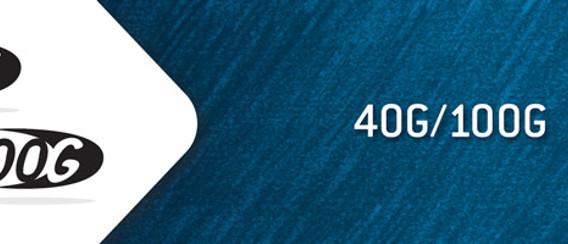Transporting 40G/100G Ethernet Services over Optical Networks
There is no question that telecom service providers are challenged more than ever before to accommodate the traffic growth in metro and long-haul networks. Among the obvious options that service providers may consider, lighting up more fiber is one of them. Yet this can involve installing additional fiber and/or new hardware—making this option inadequate and expensive. Service providers may also pursue the option of adding more wavelengths to existing fibers; however the existing fiber chromatic and polarization-mode dispersion characteristics can set limitations to narrower channel spacing performance. Finally, service providers may consider increasing the transmission rate on existing networks—by upgrading from 10G to 40/100G, carriers can preserve much of their existing fiber infrastructure and transport networks.
In response to the telecom industry’s need for increased bandwidth, the IEEE High Speed Study Group (HSSG) was formed to commence development of both the 40 GigE and 100 GigE standards. Meanwhile, there has been a close liaison between the IEEE and the International Telecommunication Union’s (ITU). Fortunately, the ITU Study Group 15 approved the extension of the G.709 optical transport network (OTN) standard to the next higher rate beyond the current OTU3 (43 Gbit/s) and defined OTU4 (112 Gbit/s) as the new optimal rate for carrying 100 GigE client services using generic mapping procedure (GMP).
Generic Mapping Procedure (GMP)
Today, ITU-T G.709 defines two approaches for mapping constant bit rate (CBR) and packet-based client signals over OTN. The client signal can either be mapped using ODUflex—an aggregate of n x 1.25 Gbit/s tributaries—with a bit rate suitable for the client signal or mapping the client signal directly into ODUk using GMP if the bit rate of the client signal is close to a conventional ODUk (k = 0, 1, 2, 3, 4) rate. GMP, generally speaking, is used to accommodate the nominal bit rate difference between the client and the server—being the transport layer—and the clock variations that may occur between the two.
When mapping 40G/100G Ethernet client signal into OTU3/OTU4, the server frame (or multiframe) may contain data or additional information. In this mapping process, data will be distributed as evenly as possible across the server frame. In addition, it is fundamental for the transmitter and the receiver to know the amount of data filled into each frame or multiframe to ensure the proper mapping and de-mapping of the client signal.
Using GMP, the OPUk overhead includes the usual payload structure identified (PSI) with its payload-type (PT) byte and another six justification-control (JC1, JC2, JC3, JC4, JC5 and JC6)) bytes as shown in figure 1. The JC1, JC2 and JC3 bytes consist of a 14-bit Cm field (bits C1, C2, . . . , C14), a 1-bit increment indicator (II) field, a 1-bit decrement indicator (DI) field and an 8-bit CRC-8 field, which contains an error check code over the JC1, JC2 and JC3 fields. GMP uses these justification-control bytes to inform the receive end of the number of payload bytes that are transported by the OPUk payload area; this is done for each frame. The number of payload bytes transported is signaled by the Cm ‘word’ and the change of the number of bytes transmitted in the OPU frame is signaled with the two designated bits: increment indicator and decrement indicator. The JC4, JC5 and JC6 bytes on the other hand consist of a 10-bit CnD field (bits D1, D2, . . . , D10), a 5-bit CRC-5 field, which contains an error check code over the bits 4 to 8 and 9 reserved bits for future international standardization (RES). GMP uses the CnD parameter to provide a mechanism to accommodate client signals that need to meet tighter jitter requirements (i.e., SONET/SDH client signals).

Figure 1. GMP justification-control bytes
Mapping 40G/100G Ethernet over OTN
A 100G Ethernet client signal running at 103.125 Gbit/s rate can be mapped directly into an OPU4 payload area (104.35 Gbit/s) using GMP. However, it is not as simple in the case of a 40G Ethernet client signal, see figure 2. The 40G Ethernet signal (41.25 Gbit/s) uses 64B/66B line coding, making it slightly larger than the standard OPU3 payload area (40.15 Gbit/s). Therefore to transport 40G Ethernet service over ODU3, the 64B/66B blocks are transcoded into 1024B/1027B block code to reduce their size. The resulting (40.117 Gbit/s) transcoded stream is then mapped into a standard OPU3 using GMP.

Figure 2. 40G/100G Ethernet mapping into OPU3/OPU4
Addressing the Demand
As carriers try to satisfy the never-ending bandwidth requirements, 40G/100G Ethernet deployments start to look attractive. However, the ability to cost-effectively transport 40G/100G Ethernet services across the WAN is crucial. Today, EXFO’s 40G/100G portable solution, composed of the portable FTB-500 platform and the FTB-85100G Packet Blazer 100G/40G Ethernet Test Module, offers a complete suite of testing capabilities for commissioning, turning-up and qualifying 40G and 100G Ethernet services running over OTNs. Using this solution, service providers can map 40G/100G Ethernet services over OTNs with different traffic characteristics, run end-to-end, bit error-rate (BER) tests across the OTN and measure the ratio of the error bits compared to the number of sent bits. In this testing configuration, the FTB-85100G Packet Blazer provides complete analysis of the OTU3/OTU4 (including optical channel payload unit (OPU), optical data unit (ODU), optical transport unit (OTU) and OTL layers) related alarms, errors and skew measurements. The 40G/100G module further provides GMP-related measurements, including Cm and CnD statistics, to ensure proper recovery of the client signal at the receive end. Once the OTN (with the embedded 40G/100G Ethernet client service) is qualified, end-to-end, service providers can take their service validation a step further by qualifying the actual 40G/100G Ethernet service from client-to-client. This includes validating the 40G/100G Ethernet IP traffic transmission with 100 percent throughput and ensuring that latency measurement does not impact their customers’ service level agreements (SLAs).
Conclusion
OTN-based networks are becoming the "networks of choice" for carriers who demand a stable and resilient method of delivering 40G/100G Ethernet services. With EXFO’s FTB-85100G newly introduced Ethernet-over-OTN testing capability, service providers can be sure that all new 40G/100G circuits in service are proven capable of handling any of the demanding services that may be placed on them in the future. These test routines, when performed without the proper 40G/100G test equipment, can prove complex and cumbersome.




